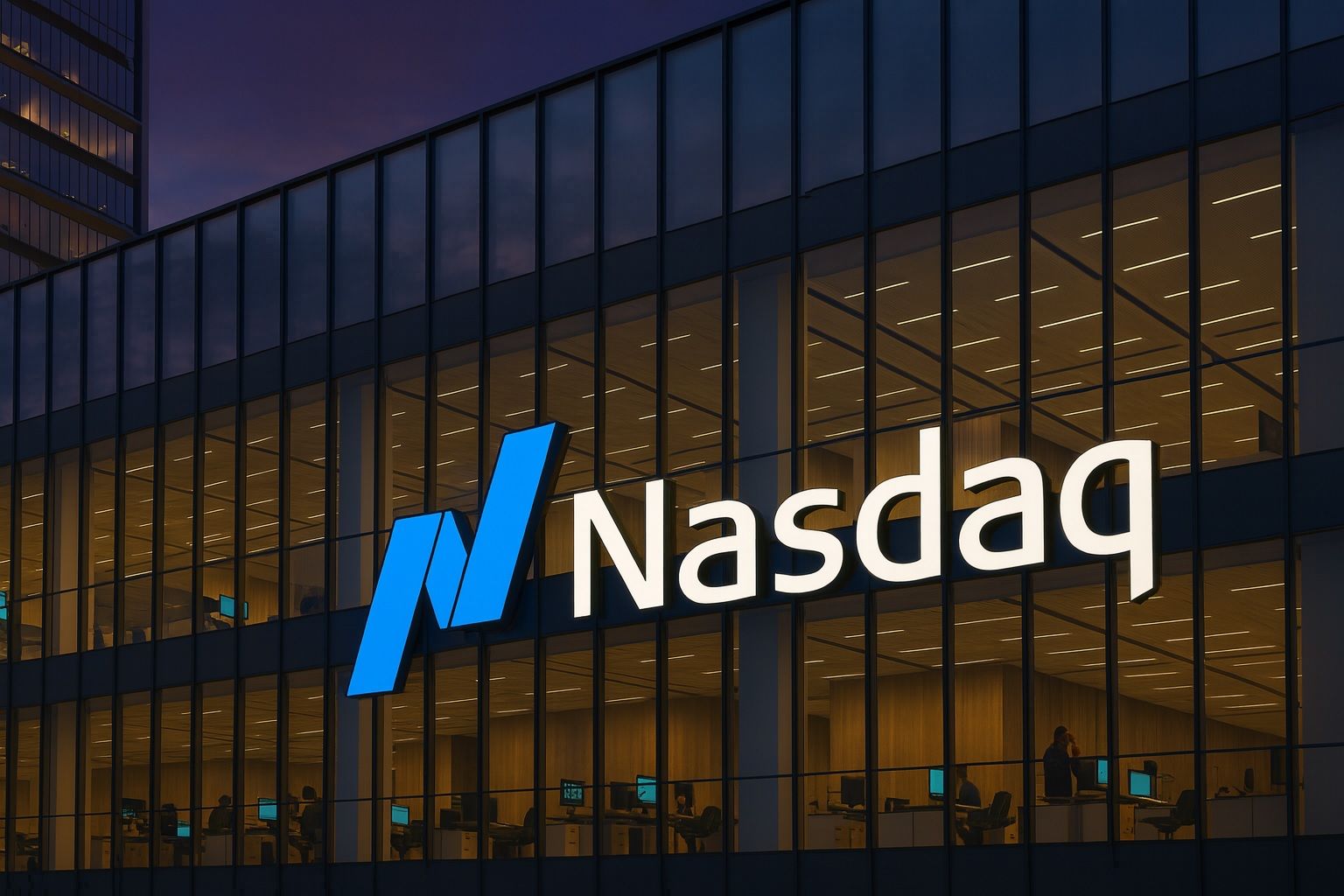- Wall Street Hits All-Time Highs: U.S. stocks surged to fresh record levels late last week. The Dow Jones Industrial Average closed above 47,000 points for the first time ever, jumping 473 points (+1.0%) on Friday to 47,207 [1]. The S&P 500 climbed +0.8% and the Nasdaq Composite +1.1%, as cooling inflation data and robust tech earnings bolstered investor confidence [2].
- Fed Poised to Cut Rates: Markets are now overwhelmingly betting the Federal Reserve will cut interest rates by 0.25% at its policy meeting this Wednesday (Oct. 29) [3]. A recent report showed U.S. consumer prices rose slightly less than expected in September, reinforcing hopes that inflation is moderating [4]. Another rate reduction in December is on the table if price pressures keep easing [5]. Fed Chair Jerome Powell’s comments will be closely watched for clues on whether this cut is a one-off or the start of a broader easing cycle [6].
- U.S.-China Trade Truce in Sight: President Donald Trump is slated to meet Chinese President Xi Jinping later this week, with officials expected to finalize a “Phase One” trade deal that was hashed out by negotiators over the weekend [7]. The tentative agreement aims to halt further U.S. tariff hikes and roll back some Chinese export curbs (including on rare-earth metals) to de-escalate the trade war [8]. Optimism about this potential Trump-Xi trade truce has lifted markets globally, though analysts note investors will want confirmation that any deal truly sticks [9].
- Big Tech Earnings Wave: A mega-cap tech earnings blitz is set to hit just as the Fed meets. Microsoft, Alphabet (Google’s parent) and Meta Platforms report results on Wednesday (hours after the Fed decision), followed by Apple and Amazon on Thursday [10]. These five giants – part of the market’s “Magnificent Seven” – collectively account for roughly one-third of the S&P 500’s market value [11]. Their earnings and forecasts on cloud spending and AI trends will be pivotal in determining whether the market’s rally can sustain its momentum [12].
- Cautious Optimism – Bubble Fears Linger:Analysts remain broadly bullish but are urging some caution. The backdrop of easing inflation and strong earnings is undeniably positive – when rates are falling and profits are rising, “markets don’t go down very much,” as one strategist noted [13]. However, the frenzy for high-flying tech stocks has some experts warning of “signs of a bubble” in valuations [14]. Any hawkish surprise from the Fed or a setback in trade talks could quickly jolt markets, they warn, even as the current risk-on mood has bulls firmly in control for now [15].
Markets Soar to Record Highs on Fed and Trade Optimism
Wall Street enters this week riding a wave of euphoria. Last Friday’s cooler-than-expected inflation report ignited an end-of-week rally, sending all three major U.S. indices to all-time highs [16] [17]. The Dow’s historic close above 47,000 was accompanied by the S&P 500 and Nasdaq Composite also finishing at record levels [18]. Wall Street’s “fear gauge,” the VIX volatility index, sank to its lowest in months as investors piled into risk assets [19].
The rally was fueled by easing price pressures and upbeat earnings. The September Consumer Price Index (CPI) showed inflation rising just 3.0% annually – slightly cooler than forecast – bolstering hopes that the Fed will finally pivot to rate cuts [20] [21]. “That boosted expectations that the Federal Reserve will cut interest rates at its upcoming policy meetings next week and in December,” noted CNN, after the benign inflation data came out [22]. At the same time, corporate earnings continue to impress: tech giants like AMD and Nvidia blew past forecasts, sparking big stock pops and reinforcing the market’s faith in the profit outlook [23] [24]. “When the Fed is lowering rates and earnings are good, markets don’t go down very much,” observed Bob Doll, CEO of Crossmark Global Investments, summing up the market’s buoyant mood [25]. In short, investors are seeing a “broadly supportive environment” for equities, as one fund CIO put it, given the combination of cooling inflation, prospective Fed easing, and solid earnings growth [26].
That upbeat sentiment has reverberated worldwide. Asian markets kicked off Monday with a bang – Japan’s Nikkei index surged past 50,000 for the first time ever, and South Korea’s KOSPI jumped above 4,000 – amid optimism about a U.S.-China trade thaw [27]. European stocks followed suit, with the pan-European STOXX 600 index brushing up against record highs on Monday [28]. In Europe, resource and tech shares led the charge, while traditional safe havens like gold and government bonds pulled back as traders rotated into riskier assets [29]. (Spot gold actually fell about 2% Monday to around $4,028/oz – off its recent record highs – reflecting better risk appetite [30].) “Better risk conditions and some improvement in global growth expectations should result in the U.S. dollar weakening as investors look at better prospects for non-dollar currencies,” explained Derek Halpenny, MUFG’s research head, on the broader shift away from safety [31] [32]. In other words, investors’ current optimism is cutting across regions – though many are also mindful that this rosy scenario could change quickly if key events disappoint.
Fed Meeting Looms: Rate Cut Baked In, All Eyes on Powell’s Signal
The spotlight now turns to the Federal Reserve’s high-stakes meeting on Wednesday, October 29. Following 19 months of aggressive rate hikes, the Fed is widely expected to deliver a 0.25% interest rate cut this week – which would be its second rate reduction of 2025 [33] [34]. Such a move would bring the benchmark federal funds rate down to roughly 3.75–4.00%, marking a notable policy shift toward easing as economic headwinds emerge [35]. Futures markets have essentially priced in a quarter-point cut with near certainty, especially after the recent tame inflation readings [36]. “Market watchers expect the Federal Reserve to reduce interest rates for a second time this year when it concludes its meeting on Wednesday,” Investopedia noted, with a quarter-point cut largely priced in by investors [37].
What’s less certain – and thus of greater market interest – is the tone of Fed Chair Jerome Powell’s guidance. Will he hint at further easing to come, or signal a pause? Traders are eagerly awaiting Powell’s 2:00 pm press conference on Wednesday for any clues on whether another cut in December is likely. Harun Thilak of Validus Risk Management said the downside inflation surprise “should further embolden expectations” for yet another cut by year-end, assuming the labor market stays soft [38]. Indeed, some on Wall Street think a “one-and-done” cut is unlikely, given that core inflation is still above 3% and economic growth is slowing [39] [40]. On the other hand, a few more hawkish Fed officials have cautioned against easing too much, arguing policy may already be sufficiently accommodative to tame inflation [41]. Powell will have to balance these views. Any hint that Wednesday’s cut might be the last – or conversely, an open door to more stimulus – could jolt markets. A reassuringly dovish tone may extend the stock rally, while a noncommittal or hawkish surprise could douse some of the enthusiasm [42] [43].
Complicating the Fed’s job is the ongoing U.S. government shutdown, now entering its fourth week. The data blackout from shuttered agencies means the Fed is “just flying blind without fresh jobs or inflation figures,” warned David Seif of Nomura [44] [45]. Key economic reports (like the September jobs report and retail sales) have been delayed, forcing policymakers to rely on private-sector data and anecdotes to gauge the economy [46]. This uncertainty might make the Fed more cautious in projecting next steps. For markets, the 25 bp cut itself is almost fully anticipated – it’s Powell’s forward-looking comments that will be the real wildcard. As such, expect outsized market swings on Wednesday afternoon based on not just what the Fed does, but how Powell frames the outlook going into 2026.
Trump-Xi Summit to Seal Trade Deal Framework
On the trade front, investors are cheering a thaw in the U.S.–China economic standoff. Over the weekend, top negotiators from Washington and Beijing reportedly hammered out the broad framework of a trade agreement for their leaders to approve [47]. That sets the stage for a highly anticipated meeting between President Donald Trump and China’s President Xi Jinping in South Korea later this week, where the two are expected to formally agree to the deal [48]. According to Reuters, this potential accord would pause new U.S. tariffs on Chinese goods and ease some of China’s recent export restrictions (for example, planned bans on exporting certain rare-earth minerals critical to tech manufacturing) [49]. Essentially, it would solidify a long-sought trade truce between the world’s two largest economies, after over two years of on-and-off trade wars.
The mere prospect of a U.S.-China deal has already buoyed markets. Global stocks jumped on Monday as optimism spread that the Trump-Xi talks will yield concrete relief on tariffs [50] [51]. “Investors will want to see confirmation that the trade truce holds and that China’s stimulus and reform signals translate into tangible growth momentum,” cautioned Charu Chanana, chief investment strategist at Saxo Bank [52]. In other words, the market’s rally is partly built on trade optimism – now it needs to see real follow-through. President Trump struck an upbeat tone as he departed for Asia, telling reporters, “I’ve got a lot of respect for President Xi and I think we’re going to come away with a deal.” That confidence, along with the White House’s confirmation of the summit’s timing, “boosted market sentiment late last week” ahead of the talks [53]. Still, seasoned analysts note that trade negotiations can be fickle. Even a partial deal could face hurdles on implementation details, and any sign of talks faltering might spook investors who have been pricing in a positive outcome. For now though, the planned Trump-Xi meeting is a major reason behind the global rally – and Wall Street will be closely monitoring headlines out of Seoul for any last-minute surprises or snags in the deal-making.
Big Tech Earnings on Deck: A Rally Reality Check
Even as macro news dominates headlines, this week also brings a crucial test from corporate America: a flood of Big Tech earnings that could make or break the market’s momentum. In what some are dubbing a “midweek double whammy,” five of the six largest U.S. tech companies release quarterly results in the next 72 hours, right as the Fed meeting unfolds [54] [55]. On Wednesday, Microsoft, Alphabet (Google), and Meta Platforms (Facebook’s parent) will report their July–September earnings after the market close – just hours after Powell’s press conference wraps up [56]. Then on Thursday, Apple and Amazon follow with their own earnings after the closing bell [57]. (The only members of the elite “Magnificent Seven” not reporting this week are Nvidia – which already delivered stellar results earlier – and Tesla, which reported last week [58].)
Why does this matter so much? These tech titans collectively are enormous – together accounting for about 33% of the entire S&P 500’s market capitalization [59]. Their stock price swings carry outsized influence on index performance. Notably, it has been tech and AI-driven stocks leading 2025’s rally: year-to-date, shares of the “Seven” (Apple, Microsoft, Google, Amazon, Meta, Tesla, Nvidia) have dramatically outpaced the broader market. Strong earnings from this group could reinforce the rally’s foundations by showing that high valuations are justified by robust growth. For example, investors will scrutinize cloud-computing revenues at Microsoft and Amazon, ad sales at Google and Meta, and iPhone demand for Apple – all bellwethers for tech sector health [60] [61].
Conversely, any disappointments or cautious outlooks from these giants could quickly test the market’s resilience. Short-term options markets are pricing in significant post-earnings stock moves for names like Alphabet and Amazon, reflecting traders’ jitteriness [62]. If, say, cloud spending is slowing or AI product monetization isn’t meeting the hype, it could deflate some of the exuberance that has built up around tech. Given that valuations for many of these companies are stretched near historic highs, even a minor miss on earnings or guidance can trigger sharp selloffs. “Following a much-needed correction, traders will likely pause… before concluding the developments that drove the historic rallies… have not gone away,” noted Ole Hansen of Saxo Bank, referring to how sensitive the market may be to any hint of trouble [63] [64]. In sum, the tech earnings deluge arriving alongside the Fed decision will be a critical barometer. Blowout results could extend the stock market’s record run, while any big tech stumbles may remind investors that even in a bull run, fundamentals still matter.
Outlook: Bulls in Control, But Watch for Bubbles and Blips
After a stunning October surge, many on Wall Street believe the market’s uptrend has more room to run into year-end – albeit with the caveat that risks are rising as well. “Some analysts say the rally might just be getting started,” reported CNN, given the supportive combination of Fed easing and resilient corporate profits [65] [66]. UBS strategists, for instance, argue that “the bull market remains intact” despite recent volatility, calling any dips mere buying opportunities as long as the economic backdrop remains benign [67]. The equity risk premium (stocks’ yield vs. bonds) still favors stocks, they note, especially if interest rates begin a sustained decline.
That said, virtually everyone agrees that vigilance is warranted at these heights. Valuations are no longer cheap – the S&P 500’s forward price/earnings ratio is creeping toward levels that assume a lot of good news. The frenzied rush into anything AI-related this year has even prompted comparisons to past tech bubbles. Reuters recently pointed out “there are signs of a bubble” – citing frothy flows and soaring valuations for concept-stage AI startups and speculative tech plays [68]. If this week’s Big Tech earnings show any cracks, it could quickly “let some air out” of the hottest AI-driven stocks, analysts warn [69]. Peter Oppenheimer, Goldman Sachs’ chief global equity strategist, cautions that higher-for-longer interest rates (if the Fed surprises) or a resurgence of inflation could also upend the current narrative of a smooth landing and indefinite Fed support.
For now, the bulls remain firmly in control and market momentum is undeniable [70]. The combination of a potential Trump-Xi trade truce, a dovish Fed pivot, and blockbuster tech profits has created something of a “perfect positive storm” for stocks in recent weeks. “It’s just a continuation of a broadly supportive environment for equities,” noted Peter Fitzgerald, Macro CIO at Aviva Investors, describing the low-volatility, pro-growth backdrop powering the rally [71]. Still, veteran investors know that complacency is dangerous. As one market strategist quipped, “Trees don’t grow to the sky, and even the best rallies take breathers.” Any misstep – a breakdown in trade talks, an inflation surprise, a geopolitical shock – could remind traders that risk hasn’t vanished. In the meantime, though, the mood is clearly optimistic. Barring any surprises, many expect stocks to finish 2025 on a high note, riding the tailwinds of easier monetary policy and easing global tensions. The next few days, with their flurry of crucial events, will test whether that optimism is truly justified – or if the market has gotten a bit ahead of itself in the rush to new heights.
Sources: CNBC [72] [73], Bloomberg [74] [75], Reuters [76] [77], TechStock² (ts2.tech) [78] [79] [80], CNN [81].
References
1. www.wral.com, 2. www.wral.com, 3. ts2.tech, 4. www.reuters.com, 5. ts2.tech, 6. ts2.tech, 7. www.reuters.com, 8. www.reuters.com, 9. www.reuters.com, 10. ts2.tech, 11. ts2.tech, 12. ts2.tech, 13. www.wral.com, 14. ts2.tech, 15. ts2.tech, 16. www.wral.com, 17. www.wral.com, 18. www.wral.com, 19. www.wral.com, 20. www.wral.com, 21. www.reuters.com, 22. www.wral.com, 23. ts2.tech, 24. ts2.tech, 25. www.wral.com, 26. ts2.tech, 27. ts2.tech, 28. ts2.tech, 29. ts2.tech, 30. www.reuters.com, 31. www.reuters.com, 32. www.reuters.com, 33. ts2.tech, 34. ts2.tech, 35. ts2.tech, 36. ts2.tech, 37. ts2.tech, 38. ts2.tech, 39. ts2.tech, 40. ts2.tech, 41. ts2.tech, 42. ts2.tech, 43. ts2.tech, 44. ts2.tech, 45. ts2.tech, 46. ts2.tech, 47. www.reuters.com, 48. www.reuters.com, 49. www.reuters.com, 50. www.reuters.com, 51. www.reuters.com, 52. www.reuters.com, 53. ts2.tech, 54. ts2.tech, 55. ts2.tech, 56. ts2.tech, 57. ts2.tech, 58. ts2.tech, 59. ts2.tech, 60. ts2.tech, 61. ts2.tech, 62. ts2.tech, 63. ts2.tech, 64. ts2.tech, 65. www.wral.com, 66. www.wral.com, 67. ts2.tech, 68. ts2.tech, 69. ts2.tech, 70. ts2.tech, 71. ts2.tech, 72. www.wral.com, 73. www.wral.com, 74. www.reuters.com, 75. www.reuters.com, 76. www.reuters.com, 77. www.reuters.com, 78. ts2.tech, 79. ts2.tech, 80. ts2.tech, 81. www.wral.com





